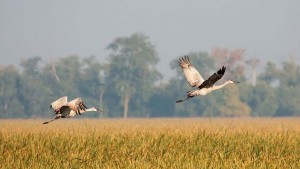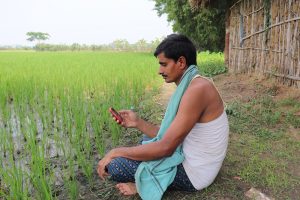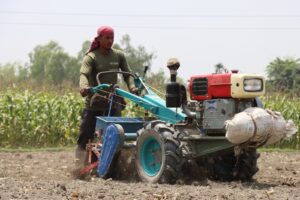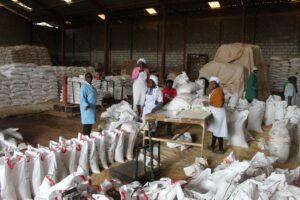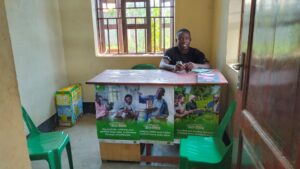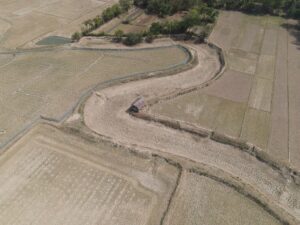
SRI LANKAN Farm workers prepare to plant rice on a farm in Bathalagoda. The term “serendipity” was coined by author Horace Walpole in 1754 after reading an ancient fairy tale titled The three princes of Serendip. The word described the accidental discovery of fortunate things, after the many fortuitous findings by the story’s heroes. The Arabic term “Serendib” (also spelled “Serendip”) has been used to describe the island of Sri Lanka, regarded as an isle of unparalleled beauty and enumerable natural resources, since as early as AD 361.
Among the many natural blessings that mark Sri Lanka is vast, fertile terrain well suited for the growth of many crops, including rice, the staple food for the 21 million inhabitants of this South Asian nation. The importance of rice within Sri Lanka, however, extends well beyond its status as the primary food source, with integral roles in cultural identity, tradition, and politics.
Rice is grown primarily on irrigated land in Sri Lanka’s “dry zone,” an area spanning most of the country’s north-central and northeastern regions, and secondarily on rainfed (nonirrigated) land by smallholder farmers across the county. In 2007, Sri Lanka’s rice industry made up 5% of the nation’s gross domestic product. Almost one-third of the labor force is directly involved in the rice sector. Currently, the per-capita consumption of rice is 108 kilograms per year. Although rice, until recently, offered minimal financial return for farmers, its social, cultural, and political significance has ensured that successive governments since independence have paid it due attention.
The current state of the rice industry in the Serendib isle is thus a story of sound research, investment in irrigation, and organized extension (technology dissemination) spanning two millennia. Over that time, the country has remained self-sufficient, or close to it, in rice. In recent times, however, the grail of self-sufficiency has proved somewhat more elusive, despite surplus years in 2004 and 2005.
The Sri Lankan rice industry can be traced back to the ancient kingdom of Anuradhapura, the first capital of this island nation, which flourished between 161 BC and AD 1017. Many ancient kings of this early kingdom developed large reservoirs and mazes of interconnected canals to irrigate the rice fields of their constituents. Reservoirs and waterways built by the kings of this golden era are to this day being used by rice farmers in the dry zone for irrigation. Many of these ancient works have been rehabilitated and maintained under the Mahaweli River diversion program, implemented during the 1980s to ensure reliable water availability.
A more recent renaissance of the rice industry can be sketched back to the establishment of the Rice Research and Development Institute (RRDI) in 1929 in Bathalagoda, a quaint rural town 110 kilometers northeast of the capital, Colombo. RRDI’s successes include an improved variety, released in 1968, named Bg 11-11, which achieved yields of up to 8–9 tons per hectare. The 1970s and 1980s were dedicated to developing high-yielding varieties resistant to a host of pests and diseases prevalent in Sri Lankan rice fields such as brown planthopper, bacterial leaf blight, rice blast, and rice gall midge.

Current research at RRDI concentrates on the development of higher yielding hybrid rice varieties, the effects of climate change on rice production, soil fertility and nutrient management, and weed control. Hybrid varieties in particular have received recent attention through a project supported by the Asian Development Bank, the International Rice Research Institute (IRRI), and the Food and Agriculture Organization (FAO) of the United Nations. Technical assistance is being provided by IRRI and the government of China. The FAO has also approved US$329,000 for hybrid rice development and popularization.
In 2007, the first modern commercial hybrid rice variety, Bg 407H, was developed at RRDI by a team led by senior plant breeder S.W. Abeysekera. Approximately 1,000 kilograms of Bg 407H seed was distributed island-wide. Able to achieve yields of up to 11 tons per hectare, Bg 407H is also resistant to rice blast and many natural pests, is salt tolerant, and possesses high grain quality, including long and strong grain body, favorable aroma, and short cooking time.
Since high-quality seed is crucial for hybrid rice farming, RRDI researchers have introduced a technique to improve seed germination without additional financial and labor costs. The method, termed “parachute sowing,” involves placing seeds in specially developed trays possessing 434 wells, each 2 centimeters deep and filled with soil. One to three seeds are sown in each well and, 12 days later, the emerging plants are removed with the surrounding soil intact. The seedlings are then hand sewn into the field. The parachute like appearance of the soil “cap” is responsible for the technique’s name.
Over the past two decades, Sri Lanka has been able to produce more than 85% of the rice needed to fee its population. In 2004-05, favorable weather during both cultivating seasons—Maha (September to March) and Yala (April to August)—resulted in a national surplus. However, 10–15% of the country’s rice has been routinely imported from Thailand, Vietnam, Myanmar, and, to a lesser extent, India.
Despite years of regal intervention, historical and modern infrastructure suited for year-round irrigation, efficient research, sound management and extension services, and gradual innovation, Sri Lanka was not immune to the global food crisis of 2008. Food and fuel prices have risen sharply and, combined with high government spending, caused inflation to hit a dangerous 28% in June 2008.
_____________________________________________






